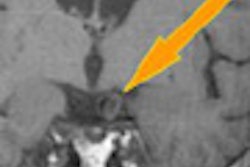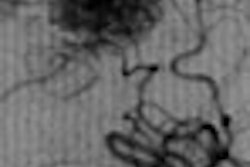Pediatric imaging represents one of the most vexing problems for imaging specialists. It's well-known that infants and children are more susceptible to the negative effects of radiation, but x-ray-based modalities remain a necessary component of the diagnostic process. Can digital x-ray technologies be enlisted to help?
A pair of recent studies examines that question by offering up ways to reduce pediatric radiation dose in digital x-ray exams. One study is based on computed radiography (CR), a well-established digital x-ray technology, while another uses a novel new digital radiography (DR) system that employs a slit-scanning design as a means of reducing dose.
In the first study, published online in the Journal of Digital Imaging on September 13, 2007, Spanish researchers sought to address the problem of dose creep in CR examinations -- when radiation dose delivered to patients rises following a facility's conversion from conventional x-ray to CR. They also wanted to explore a related issue, of whether the imaging parameters suggested by CR manufacturers are delivering too much dose to patients, particularly children.
The group reviewed 240 chest images taken at their facility, San Carlos University Hospital in Madrid, in the last four months of 2004. The studies were produced using CR equipment (ADC Compact, Agfa HealthCare, Mortsel, Belgium), and were processed with the company's Musica software. Radiation dose was measured using Agfa's dose level (DL) index, which estimates dose by measuring the light emitted by the CR imaging plate during the reading process.
The images were reviewed on the same PACS workstation by three radiologists working independently and blinded to the results. They scored the quality of each image using seven criteria that represented how well the image reproduced different areas of thoracic anatomy. The researchers then compared the image quality scores to the DL index used for the studies to uncover relationships between the amount of radiation dose delivered and the resulting image quality.
The results showed no strong correlation between radiation dose as represented by DL and image quality as perceived by radiologists -- meaning that dose could be reduced at their facility without harming image quality. The group found that mean DL for studies at their facility was 1.9-2.0, which could be lowered by a factor of two, to a mean value of 1.6-1.7 DL per study.
The researchers said their study paralleled that of previous research, some of which was based on CR systems from other manufacturers, which found that facilities should set their own exposure index guidelines rather than accept those suggested by manufacturers.
The slit-scanning approach
In the second paper, published in the October issue of Pediatric Radiology (Vol. 27:10, pp. 990-997), a group of researchers from South Africa described their experiences with a slit-scanning DR unit (Statscan, Lodox Systems, Benmore, South Africa) designed to produce a lower radiation dose than existing DR systems.
Like some other DR designs, the Statscan system uses digital detectors based on charge-coupled device (CCD) technology. But instead of employing a stationary x-ray tube and detector, the system mounts the x-ray tube on a C-arm that rotates around the patient up to 100°, with the digital detector at the other end of the C-arm. The system produces a fan-shaped x-ray beam of 1 mm or less that travels across the patient at speeds of up to 140 mm/sec, and can produce a full-body scan in less than 13 seconds.
For the study, the group compared the radiation dose for pediatric studies produced by two Statscan systems to those conducted on a conventional radiography unit (Shimadzu Medical Systems, Kyoto, Japan) outfitted with CR technology (Fujifilm Medical Systems, Tokyo). They tested the systems across a range of standard pediatric studies at two facilities in South Africa, Red Cross War Memorial Children's Hospital and Groote Schuur Hospital, both in Cape Town.
The researchers measured the radiation dose produced by the systems with a commercially available Monte Carlo simulator program that estimated the dose delivered to different organs (PCXMC version 1.5.2, STUK Radiation and Nuclear Safety Authority, Helsinki, Finland). The group also used a dose meter and ionization chamber in place of actual pediatric patients.
They found that the effective dose delivered by the Statscan systems was markedly lower than that of the Shimadzu/CR system. For example, the Statscan system at Groote Schuur Hospital produced abdomen anteroposterior (AP) studies with an effective radiation dose of 15.95 µSv, and the unit at Red Cross Children's Hospital an effective radiation dose of 26.46 µSv. The Shimadzu/CR unit at Red Cross produced an effective radiation dose of 286.4 µSv.
The differences were not as profound for chest AP studies, although the Statscan systems still had the edge. The Statscan system at Groote Schuur Hospital produced an effective radiation dose of 12.32 µSv, while the Statscan unit at Red Cross Children's Hospital produced an effective radiation dose of 18.11 µSv. This compares to 24.9 µSv produced by the Shimadzu/CR unit at Red Cross.
Effective radiation doses for selected procedures in the study by type of equipment used are as follows. All studies were conducted on 5-year-old patients.
|
||||||||||||||||||||||||||||||||
The Statscan system had other attractive features, such as its ability to conduct a full-body scan, the group reported. The radiation dose from such an exam, at 29.4-82 µSv, is in the same range as pelvic and abdominal studies on conventional radiographic systems, and 10 such scans could be performed in a year on a patient and still be under the 1 mSv maximum radiation dose from nonmedical sources set by the International Commission on Radiological Protection.
The researchers attributed Statscan's low dose to its slit-scanning design, which reduces scatter radiation and enables the system to operate without a grid, which can attenuate an x-ray beam. In addition, the high detective quantum efficiency (DQE) found on DR systems in general contributes to the system's lower dose, they reported.
The group concluded by stating that previous studies had validated the image quality of the Statscan system in comparison to conventional radiography units.
By Brian Casey
AuntMinnie.com staff writer
September 9, 2007
Related Reading
New CR technology boosts resolution, bags R&D award, September 3, 2007
PACS data-mining technique tackles CR dose creep, July 30, 2007
DICOM-compliant displays aid CR/DR exposure control, July 17, 2007
CR/DR image quality: Issues and concerns, April 12, 2007
Strategies for reducing 'dose creep' in digital x-ray, April 11, 2007
Copyright © 2007 AuntMinnie.com



















